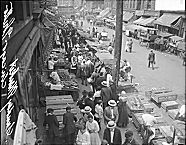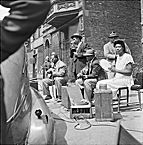| Entries |
| M |
|
Maxwell Street
|
For about one hundred years, Maxwell Street was one of Chicago's most unconventional business —and residential—districts. About a mile long and located in the shadow of downtown skyscrapers, it was a place where businesses grew selling anything from shoestrings to expensive clothes.

|
Goods on card tables and blankets competed with goods in sidewalk kiosks and stores. Sunday was its busiest day since the Jews worked on the Christian Sabbath, when stores were closed in most other parts of the city.

|
Bibliography
Berkow, Ira.
Maxwell Street: Survival in a Bazaar.
1977.
The Electronic Encyclopedia of Chicago © 2005 Chicago Historical Society.
The Encyclopedia of Chicago © 2004 The Newberry Library. All Rights Reserved. Portions are copyrighted by other institutions and individuals. Additional information on copyright and permissions.
The Encyclopedia of Chicago © 2004 The Newberry Library. All Rights Reserved. Portions are copyrighted by other institutions and individuals. Additional information on copyright and permissions.